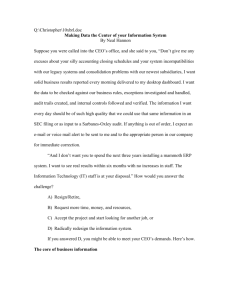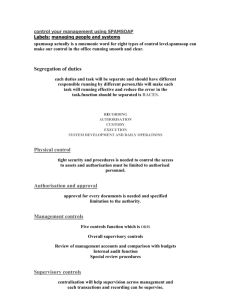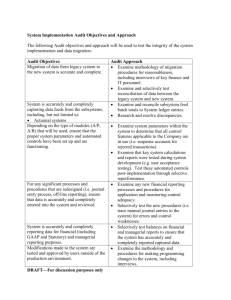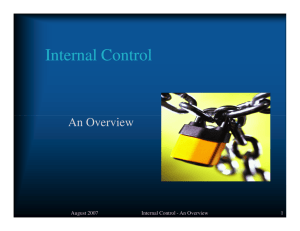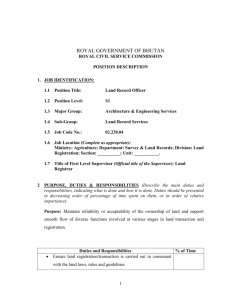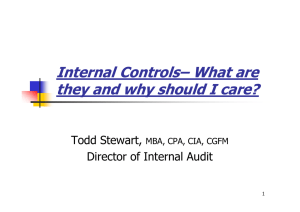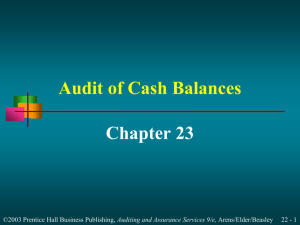Internal Controls - Internal Audit Department
advertisement
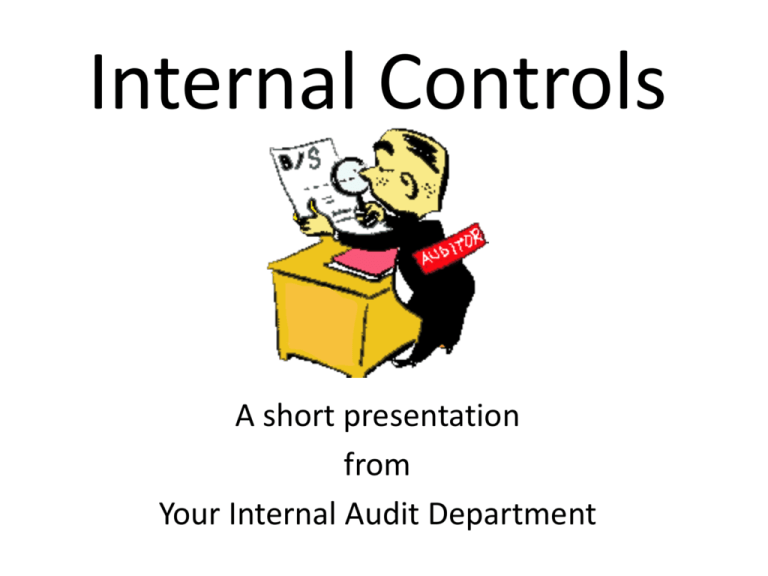
Internal Controls A short presentation from Your Internal Audit Department The Old Internal Audit Department The New Internal Audit Department “We’re here to help!” Teach + Train = Change Our goal: Promote effective, efficient and ethical practices and procedures Let’s start with some Basics – What are some terms we will use in discussing Internal Controls? Definitions Process: a group of logically related activities that transform inputs into outputs. Process Owner: a person who is ultimately responsible for the process. Process Inputs: the material, capital, human resources and information that a business process receives and acts upon in order to transform it into its output. Process Activity: a specific deed, action or function designed on its own or with other related activities to turn input into output. Process Outputs: those things transformed by a process for the benefit of the customer or for use as an input in a later process or activity. Some more definitions Policy: the principles that guide the actions and decisions in an organization. Policies do not tell “how” to do something, but specify what is acceptable, unacceptable, right and wrong. Procedures: the established or prescribed methods to be followed. They describe “how it should be done.” Routine transactions: recurring activities performed in the normal course of business. Example: Cash disbursements Non-routine transactions : activities that occur periodically that are not part of the routine flow of transactions. Example: Sale of fixed assets What are internal controls and who is responsible for them? What are Internal Controls? Process steps installed by Management to provide reasonable assurance of the following objectives: effectiveness and efficiency of operations reliability of financial reporting accomplishment of established goals and objectives compliance with laws and regulations Why do we want them? To minimize RISK. What is risk? The possibility that an organization will NOT: achieve its goals operate effectively and efficiently protect itself from loss (fraud) provide reliable financial data comply with laws and defined policies How and Why Fraud Occurs Incentive / Pressure Medical bills Opportunity Fraud Triangle No one ever counts the money in the safe Attitude / Rationalization I need it more than they do Internal Controls diminish opportunity How do you determine if and where controls needed? Document the Process! 1. Pick a method that suits the process: Flowchart or Narrative 2. Identify policies that impact the process; identify standards that may specify mandatory controls. 3. Identify process owner and activity owners 4. Identify the key inputs, activities, outputs, risk points Points of Risk Higher Risk Transactions Purchase of Goods Purchase of Services Cash Receipts Payroll operations Inventory operations Critical Functions Authorizing transactions Reconciling transactions Custody of assets Recording transactions Segregation of duties is a preventive control that aids in the timely detection of errors and irregularities in the normal course of business. Key to Defeating Opportunity for Fraud: Divide key functions so that no one person has control over all parts of a transaction. Higher Level Controls designed to frame organizational behavior and performance Design controls to mitigate identified risks How to document a control: who, what, when, why, how Internal Controls -Types to Consider Policies and Procedures Policies are rules established to reduce risk. A procedure is instruction that outlines a series of steps taken to ensure that an internal control is followed. Education and Awareness Training Methods used to periodically inform (e.g., job-specific training, faculty / staff meeting topics, orientation for new employees, email or web site information, simulations, newsletters, or postings). Operational Controls DOCUMENTATION that confirms a particular policy or procedure was followed (e.g., receipts, tracking for mandatory training, account reconciliations). PHYSICAL or SYSTEM CONTROLS that are built-in (e.g., access controls such as keys, door locks, restricted space, computer passwords or programs, standardized contracts to ensure compliance with UW policy, or a system-edit that is a pre-established control that will activate when certain thresholds or events occur). ADMINISTRATIVE CONTROLS refers to organization structure or the roles associated with a risk (e.g., segregation or division of duties, where different people authorize, record and/or handle a transaction process for it to be complete, competency reviews). Oversight, Monitoring or Executive Controls These controls refer to the individual, office, or persons who have been delegated responsibility to verify internal controls are used and effective: REVIEW & DOCUMENTATION is the most common (e.g., a supervisor's initial on an account reconciliation, sampling or cross checking activities). OBSERVATIONS / INSPECTIONS / INTERVIEWS formally or informally observe the control environment (e.g., scheduled or unscheduled inspections, surveys, or a walk-thru to observe activities). TRACKING such as summary reports, longitudinal studies or trend analysis are all activities that track compliance indicators or breakdowns. BENCHMARKING & PEER REVIEWS compares the quality and effect of controls in your risk area with another. Audit Controls Formal methods usually employed long after the fact, to analyze compliance. Audits may take the form of forensic analysis of documents, sampled transactions, or a variety of other methods. Testing A control is only a control if it works Ask the “what could go wrong?” question: - What if the cash register breaks down? - What if we run out of change? - What if we can’t make the deposit today? Develop and distribute written procedures describing operational guidelines Mitigating controls when segregation of duties is lacking In a small organization where the IS support may only consist of a few people, compensating control measures must exist to mitigate the risk resulting from a lack of segregation of duties. Mitigating controls might include: ● Audit trails : Audit trails are an essential component of all well-designed systems. They help by providing a map to retrace the flow of a transaction. They enable the ability to recreate the actual transaction flow from the point of origination to its existence on an updated file. In the absence of adequate segregation of duties, good audit trails may be an acceptable compensating control. It is desirable to be able to determine who initiated the transaction, the time of day and date of entry, the type of entry, what fields of information it contained, and what files it updated. Best Practice would also involve a process for regular review of audit trails. ● Reconciliation: Reconciliation is ultimately the responsibility of the user. In some organizations, limited reconciliation of applications may be performed by the data control group with the use of control totals and balancing sheets. This type of independent verification increases the level of confidence that the application ran successfully and that the data are in proper balance. ● Exception reporting: Exception reporting should be handled at the supervisory level and should require evidence, such as initials on a report, noting that the exception has been handled properly. Management should also ensure that exceptions are resolved in a timely manner. ● Transaction logs: A transaction log may be manual or automated. An example of a manual log is a record of transactions (grouped or batched) before they are submitted for processing. An automated transaction log or journal provides a record of all transactions processed, and it is maintained by the computer system. ● Supervisory reviews: Supervisory reviews may be performed through observation and inquiry or remotely. ● Independent reviews: Independent reviews are carried out to compensate for mistakes or intentional failures in following prescribed procedures. Such reviews will help detect errors or irregularities. The never-ending journey • Internal Controls are: •a means to an end, not an end in themselves. Promote Integrity and Ethical Behavior Display a commitment to competence •effected by an entity’s management and other personnel. Are not merely policy statements and procedure manuals, but people at every level of an organization. •pervasive throughout an organization, impacting all aspects of operations - people, process and technology. •expected to provide only reasonable assurance, not absolute assurance, to an organization’s management. Any questions or comments, don’t hesitate to call or write Check us out on the web at: http://www.internalaudit.uncc.edu/ University homepage Faculty & Staff Tools & Resources
